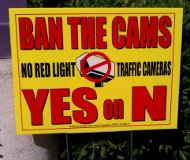10/5/2012
Analysis: Red Light Cameras Increased Accidents in Murrieta, CaliforniaReport finds Murrieta, California intersections with red light cameras more dangerous than those without.

As Election Day nears, opponents of red light cameras in Murrieta, California are making the case that photo enforcement has not made the city safer. Measure N on the November 6 ballot gives residents the opportunity to decide whether American Traffic Solutions (ATS) should continue to issue $500 tickets in the city, or the firm should be send packing. A new analysis of traffic accidents at photo enforced intersections in the city provides powerful ammunition to camera opponents who dispute the safety claims of proponents.
Safer Streets LA Executive Director Jay Beeber used the California Highway Patrol's Statewide Integrated Traffic Records System to examine accident rates before and after the installation of traffic cameras. Beeber's investigation of collision data in Los Angeles helped convince local leaders to end the program in California's largest city. Beeber believes Murrieta's cameras have not helped public safety.
"Both red light related collisions and rear end collisions increased at intersections with red light cameras in the period after the cameras were install as compared to a similar time period before camera installation," Beeber wrote. "This trend is also apparent after adjustments are made for increases in population. Also, considering the relatively small number of red light related collisions that occurred at the three photo enforced intersections in the years leading up to installation of the red light cameras, the implementation of photo enforcement at these locations cannot be justified for safety reasons."
At the intersection of Murrieta Hot Springs and Margarita, the red light camera was installed even though there had only been two accidents caused by red light running in the previous five years. Likewise at Clinton Keith and Nutmeg, there was a single red light running crash in the five years prior to installation. At Murrieta Hot Springs and Whitewood Road, there were two accidents caused by red light running before the camera was activated.
Together, the number of red light running accidents increased 78 percent and rear end collisions jumped 199 percent while the cameras were operational (figures are adjusted to reflect increases in population over the study period). Beeber then compared this to three intersections without photo enforcement. He found at the camera-free intersections red light related accidents dropped 49 percent over the same period. City wide, these accidents dropped 27 percent.
Proponents of red light cameras are doing what they can to ensure the cameras stay up. Residents report a poll is being conducted and "Vote Yes on N to Ban the Cams" campaign signs are being torn down.
"We do not know who is behind it," Diana Serafin said in an email. "We have had at least 15 yard signs taken from people's front yards. I got permission from corner houses home owners and the signs have been removed. Are we really a safe city?"
A copy of the analysis is available in a 60k PDF file at the source link below.


